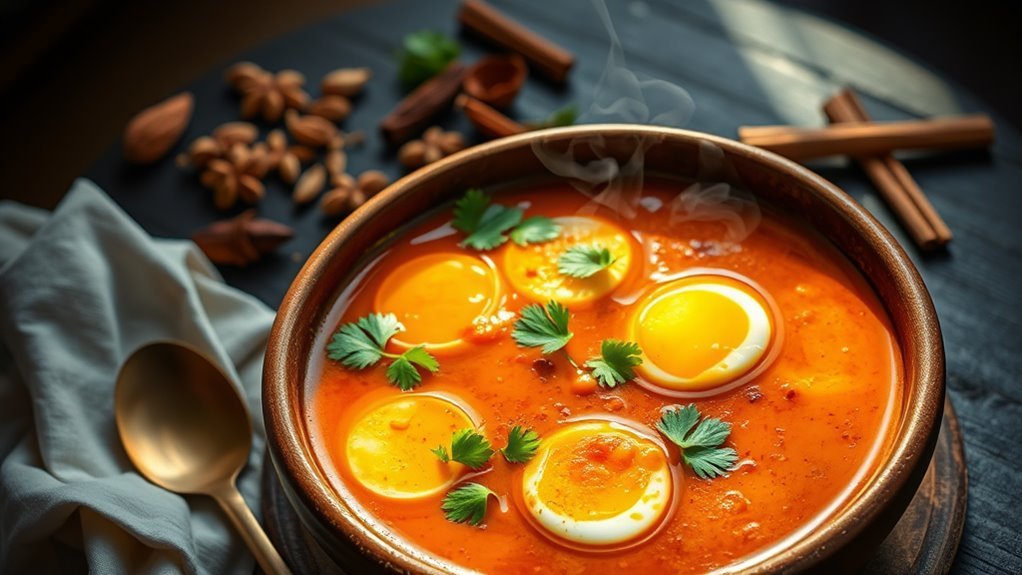Alright, let’s dive into Egg Curry, a dish that’s been warming hearts and filling bellies in homes across India for ages. This isn’t just any curry; it’s a cozy hug in a bowl, where boiled eggs mingle with a gravy that’s rich and packed with flavor. We’re talking about a blend of spices, tender onions, and juicy tomatoes that come together like a well-rehearsed dance.
Now, don’t worry if you’re not the most experienced cook in the kitchen. Egg Curry is quite forgiving and straightforward. You’ll find that the ingredients are simple, but when they come together, they create something truly delightful. So, whether you’re whipping this up for a family dinner or just treating yourself, get ready to enjoy a dish that’s not just about eating but about bringing people together. Let’s get cooking!
Ingredients

Egg curry, a beloved dish across South Asia, combines hard-boiled eggs in a rich, aromatic gravy made from a base of onions and tomatoes, enhanced with a complex blend of whole and ground spices. The curry sauce achieves its distinctive flavor through the careful layering of aromatics like green chilies and curry leaves, while warming spices such as turmeric, coriander, and garam masala create depth, with optional ingredients like cream or cashew paste adding luxurious richness to the final dish. This family favorite dish can be paired perfectly with various Indian breads and rice preparations for a complete meal.
Recipe

Egg curry is a popular South Asian dish that combines protein-rich boiled eggs with a flavorful, aromatic gravy. The dish’s versatility allows it to be adapted across various regional cuisines, from creamy North Indian versions to tangy South Indian interpretations. This cozy comfort meal can be prepared in just 30 minutes, making it perfect for busy weeknights.
The preparation involves two main components: perfectly boiled eggs and a rich curry base made with onions, tomatoes, and spices. While the basic recipe remains consistent, the gravy can be customized with different ingredients like coconut milk, cashew paste, or cream to achieve desired taste and consistency.
| Ingredient | Quantity |
|---|---|
| Eggs | 6 large |
| Onions | 2 medium |
| Tomatoes | 3 medium |
| Ginger-garlic paste | 2 tablespoons |
| Turmeric powder | 1 teaspoon |
| Red chili powder | 1 teaspoon |
| Garam masala | 1 teaspoon |
| Coriander powder | 2 teaspoons |
| Oil | 4 tablespoons |
| Salt | to taste |
| Fresh coriander leaves | ¼ cup |
Begin by hard-boiling the eggs and setting them aside. Heat oil in a pan and sauté onions until golden brown. Add ginger-garlic paste and cook until fragrant. Add tomatoes and cook until soft. Mix in all dry spices and cook until oil separates. Add water to achieve desired consistency and bring to a simmer. Make small cuts on boiled eggs and add them to the gravy. Simmer for 5-7 minutes. Garnish with fresh coriander leaves before serving.
For best results, avoid overcooking the eggs as they can become rubbery. The gravy’s consistency should be medium-thick to coat the eggs well. Pre-roasting whole spices before grinding enhances flavor. Making shallow cuts on the eggs helps them absorb the curry better. The dish tastes better when rested for 30 minutes before serving, allowing flavors to develop fully.
Cooking Tips

To create the perfect egg curry, mastering a few essential cooking tips will elevate your dish from good to exceptional.
We’ll start with whole spices like cinnamon, cardamom, and cloves to build a deep aromatic foundation.
Next, we’ll grind our onion-tomato mixture into a silky paste – this creates a luxurious base without needing cream. Using pureed onions and tomatoes helps achieve the optimal flavor and texture in your curry.
Don’t rush the caramelization process! Let those onions and tomatoes slowly develop their rich flavors. When you see the oil separating from your spice mixture, you’ll know you’re on track.
Finally, we’ll add kasuri methi for that authentic touch and fry our boiled eggs until golden-crisp.
History

While many beloved dishes have straightforward origins, the history of egg curry weaves a fascinating tale of colonial influence and regional innovation.
In India’s diverse culinary landscape, we can trace egg curry’s evolution through both colonial and local influences. The Portuguese brought chilies and vinegar, transforming traditional preparations, while British rule later standardized curry powders. The British East India Company established a strong presence that forever changed how Indian dishes were prepared and adapted.
As eggs became a popular protein choice due to their affordability and versatility, regional variations emerged. From the rich Awadhi kitchens, where we find early examples of stuffed egg curry, to the spicy Chettinad style, each region has contributed its unique touch to this beloved dish.
Final Thoughts

As we’ve explored the rich tapestry of egg curry’s history and versatility, it’s clear this dish stands as a tribute to culinary innovation and adaptability.
We love how it combines nutritional excellence with incredible flavor, offering a perfect balance of protein, healthy fats, and essential minerals.
Whether you’re following a specific diet or exploring regional variations, egg curry welcomes customization while maintaining its soul-satisfying essence. The dish provides 15 grams of protein per serving, making it an excellent choice for meeting daily nutritional needs.
From its heart-healthy properties to its blood sugar-friendly profile, this beloved dish proves that comfort food can be both nourishing and delicious.
We hope you’ll make it part of your culinary journey.

